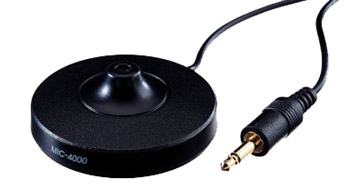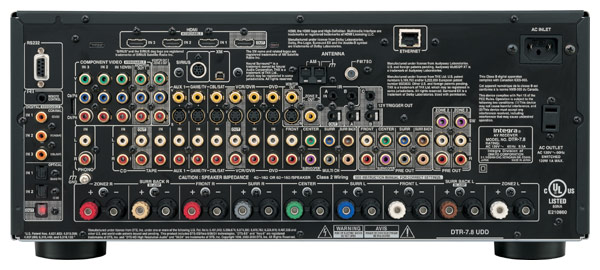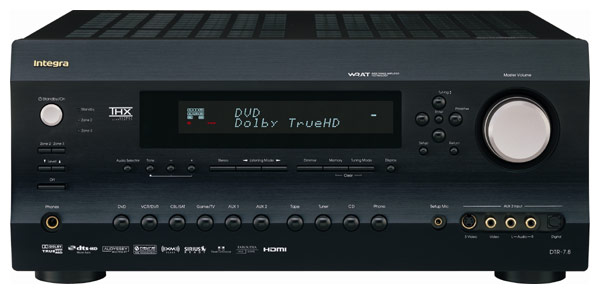Integra DTR-7.8 HDMI-Switching 1080p Home Theater Receiver Review
By Chris Boylan
A "Sound" Investment
In the world of consumer electronics, there are lulls interspersed with flurries of activity. Right now, we're in "flurry" mode as electronics manufacturers attempt to stay one step ahead of the competition, releasing (or supporting) next generation high definition displays and source devices. The format wars between HD-DVD and Blu-ray Disc and between Plasma and LCD flat panels up the ante for everyone as each side attempts to out-do the other in image and sound quality. And it's the job of the rest of the Consumer Electronics world to keep up.
Rather than just "keeping up," Japanese electronics manufacturer Integra has been blazing a trail with some of the first home theater receivers to support HDMI audio/video switching, and now the first set of receivers that support HDMI Version 1.3a and all that entails (Deep Color, and next generation bitstream audio). Their new
Integra DTR-7.8 home theater receiver is one of their latest offerings to support HDMI 1.3a, and that's not the only cutting edge feature on-board. Advanced Audyssey MultEQ speaker calibration (with on-board equalization), Sirius and XM satellite radio support, three assignable 1080p-compatible HDMI inputs and three assignable HD-capable component video inputs, plus 3 independent zones round out the feature set of this, the penultimate receiver in Integra's current line.
The Hook Up
Initial set-up of the Integra 7.8 couldn't have been much smoother. With nine distinct source devices, two HDMI switches and a component video switcher in the mix, things could have gone terribly wrong, but they didn't. The on-screen/on-LCD display menu was very clear in presenting the various input set-up options. Assigning the HDMI inputs to any of the available named inputs was quite simple and straightforward.

The Audyssey microphone measures speaker delays and frequency response in up to eight separate locations.
I took full advantage of the on-board Audyssey speaker calibration feature. Simply plug in the included microphone, hold it at ear height in the primary listening position, and let the receiver cycle through its test tones on each channel. Then repeat the process in two (or more) listening positions around the room. The Audyssey software does the rest, filling in speaker distance, crossover and even equalization levels to try to flatten out the frequency response of the system and get the best overall sound from multiple listening locations. After the fact, I verified the levels and measurements via a measuring tape and my trusty Radio Shack SPL meter. The Audyssey did at least as good a job as I could have done manually, and without the fuss.
The one glitch I had during initial hook-up was that our first generation Toshiba HD-XA1 HD-DVD player would not work via HDMI, when connected through an Impact Acoustics HDMI switcher to the Integra. I got the dreaded "HDMI ERROR I" on the Toshiba which signifies and unsuccessful HDMI "handshake." This configuration had worked properly with the Onkyo TX-SR674 receiver that we had been using previously, but not with the Integra in the mix with the HDMI switcher. Fortunately the Integra has three HDMI inputs, so I was able to connect the HD-DVD player directly to the Integra receiver and the signal came through perfectly with no error messages. This proves once again that HDMI is a complicated beast.
My only other challenges during set-up related to programming a Logitech Harmony 1000 remote to control the entire system. The Integra DTR-7.8 did show up as a device in Logitech's device database, but the input options available in the pre-configured setting (based on the Logitech database listings for the DTR-7.8) did not match the actual inputs on the Integra. Logitech named inputs such as Video 1, Video 2, Video 3, Video 4, whereas the actual inputs on the Integra receiver and on its remote were named VCR/DVR, CBL/SAT, Game/TV, etc. In order to get everything up and running, I had to teach the Logitech remote several new input commands.

The DTR7.8's remote offers backlit keys and the ability to control up to five separate devices.
But this is not a dig against the receiver, it's simply a drawback of being one of the first to use this receiver with a Harmony remote - the Logitech database simply had insufficient information in it to automatically program the remote. After a few minutes pointing the Integra remote at the back end of the Harmony, it had learned everything it needed to know to operate the new receiver, and we were on our way. Of course, the remote that comes with the Integra receiver is no slouch either, with backlighting, multi-device control - even macro support, to perform multiple commands in sequence - but I do prefer the simplicity of the Harmony remotes for handling complex activities.
For multi-room use, the receiver features three independent zones: one powered, two line level, two with video, one of which supports HD video via a component output. If you don't need all seven channels in your main system (if 5.1-channel is good enough), then you can even reallocate two of the amp channels to the second zone, so you won't need powered speakers or a second amplifier. You even have the option of re-allocating those rear-channel amps to your front left/right speakers in a bi-amplification configuration with separate amplifiers driving your high-frequency and low-frequency drivers (with speakers that support bi-amping, of course). In addition to AM and FM, the receiver also supports XM and Sirius satellite radio (requires activation). The Integra also features multi-channel pre-amp outputs in case the 130 watts/channel is not powerful enough for your cavernous listening space.
Video processing/de-interlacing is handled by on-board Faroudja/DCDi processing. Analog inputs such as composite, S-Video and component video are de-interlaced (as necessary) and then output over the receiver's HDMI jack, and over the component video outputs. This allows you to connect just a single HDMI cable between receiver and display, regardless of how many digital and analog source components are in your system.
It's important to note, however, that the the unit does
not technically "upconvert" the output of standard def or high def input signals to a higher resolution. HDMI video signals are passed through to your display device exactly as input (480i, 480p, 720p, 1080i, 1080p). Component video inputs at 1080i or 720p resolution are output at 720p over HDMI. Component video, S-video and composite video signals coming in at 480i are de-interlaced and converted to 480p for output over HDMI, and are also output over the component video ports at 480i. To get real upconversion to 1080p, you'll need to get the step-up model, the DTR-8.8, which includes the excellent Silicon Optix Reon-VX video processor.
Listening/Viewing Impressions
Ah... the fun part. Over the course of my weeks with the Integra, I had multiple occasions to sit back, watch and listen to some of the new 1080p Blu-ray Disc and HD-DVD titles, as well as my usual collection of CDs, DVD-Audio and SACD discs. The dynamic range of BD and HD-DVD titles which feature Dolby TrueHD (such as the "Matrix Ultimate Collection" and "Poseidon" on HD-DVD, and the "Legends of Jazz Showcase" on Blu-ray Disc), can really tax an amplifier's headroom. But the Integra met the challenge with aplomb, with narry a shudder, even when driving our Martin-Logan electrostats and ribbon driver speaker system (not known for being amplifier-friendly).
Gun shots and explosions were meaty, powerful and extended, but the fine microdynamics of instruments such as a stand-up base, acoustic drums, and a cappella voices were conveyed with clarity and precision. When paired with a high-end speaker system, the Integra DTR-7.8 is more than capable of producing smooth, crystal clear sound with excellent dynamic range, deep extended bass and superb midrange clarity. For CD and DVD listening (from a high-end Pioneer Elite DVD-Audio/SACD player) I tested both the analog and digital inputs. I found I preferred the digital inputs to analog, favoring the Integra's built-in D/A converter - it was a little less "edgy" than the Pioneer Elite's DAC.
For SACD and DVD-Audio playback I used the multi-channel analog input on the Integra and found that it passed the audio from the player transparently and with little editorialization. On Silverline's "Women on top" DVD-Audio sampler, remixed multi-channel versions of "girl band" classics ("We Belong to the Night" from Pat Benatar and "Only the Lonely" from the Motels) had me singing along at high volume in my best falsetto (neighbors be damned). The Integra never sounded harsh or strained, even at very high decibel levels.
I decided to swap out the Martin Logans with something a bit more affordable, bringing in my trusty NHT mini-monitors and powered sub. Here I ran into a strange problem with Audyssey calibration system. Attempting to re-calibrate the system for these new smaller speakers gave me an error message "ambient noise level is too high - Try Again?" I then went around the house unplugging every possible culprit: the HD DVR and external HDD with their built-in cooling fans; the Sony PlayStation 3 with its pleasant background whir, even the air conditioner and the refrigerator in the next room. And all I got for my trouble was some hot air and warm beer.
The ambient noise level was low enough to hear a pin drop, yet the Audyssey system still gave me the "ambient noise too high" error. So I reverted to manual calibration of the level and cross-overs for the NHT system (how tedious! Is this how we used to do it?). It's interesting to note that I tried the recalibration again about 3 weeks later with no other changes, and it worked fine, so this remains an unanswered puzzle.
Once re-calibrated for the new speakers, the system continued to perform admirably. On audiophile-quality recordings such as the Mobile Fidelity version of Rush "2112" and on DVD-audio and SACD discs, the Integra/NHT system produced pinpoint imaging and excellent soundstage depth. And on the wonderful cacophony that is the DVD-Audio version of Queen's "A Night at the Opera," the operatic voices in "Bohemian Rhapsody" surrounded me with a scary envelopment that brought home the desperation of the protagonist, as well as highlighting the fine musicianship of the players.
I experimented a bit with the various surround settings. As a THX Ultra-approved receiver, the receiver offers several THX-specific surround modes and EQ options. On discrete surround source material (multi-channel PCM, Dolby Digital 5.1, DTS 5.1), I generally left the unit in its native surround modes with no additional processing. As I was using a traditional 5.1-channel configuration, I had no need for additional processing to extract or simulate an additional rear surround channel. For stereo music listening, I usually preferred the standard "Stereo" setting, but I did enjoy the additional ambience and spaciousness of the DTS-NEO 6, Dolby Pro Logic IIx, and THX Neural Surround settings. These added a bit of space and depth to the recordings without introducing significant artifacts.
Whether you pair this receiver with a set of mid to high-end mini-monitors or something more elegant and luxurious, like Martin Logan electrostats, you'll be unlikely to be disappointed. The Integra certainly delivers the audio goods. As mentioned earlier, the receiver does include pre-amp level outputs for all channels, but it's not too likely you'll need to use these. The built-in 130 Watts/Channel amplifier has plenty of pep and headroom and never got edgy, in my listening.

The DTR-7.8 offers switching of up to 6 high definition sources with 3 component inputs (up to 1080i) and 3 HDMI inputs (up to 1080p).
Onkyo (particularly the Integra brand) is known for the quality of its tuners, and the FM tuner in the DTR-7.8 carries that tradition forward. The tuner's sensitivity and selectivity for FM listening were exceptional. I spent some time listening to the local classical station in New York City (96.3) and found the stereo separation excellent and the noise floor very deep with little audible noise even during dynamic orchestral and symphonic pieces.
As for video, high quality HDMI sources such as HD-DVD and Blu-ray Disc players, as well as our DISH Network HD DVR were passed through to the display with no visible degradation. The picture was indistinguishable from a direct HDMI hookup to the display, that is to say - beautifully detailed. But on analog sources (VCR, DVD player or DVD recorder with component video, s-video or composite video outputs), the conversion to HDMI was not the best we've seen in a receiver or video processor. It was certainly watchable, but not up to snuff with the best upconverting processors or receivers we've seen. If you watch a lot of standard definition DVDs, you'd be better off upgrading to the DTR-8.8 with its Silicon Optix upconversion circuitry, or invest in a good quality upconverting DVD player such as an Oppo, or even a HD-DVD or Blu-Ray Disc player with good upconverting circuitry. If you upconvert the standard definition material in the source component (the DVD player) then you won't have to worry about the short-comings of the Integra's video processing.
One important note about the audio testing: unfortunately, our testing of Dolby TrueHD was not via a pure bitstream signal, but was done via the player's (Toshiba HD-XA1, Toshiba HD-XA2 and Sony PS3) expansion of the lossless TrueHD track into PCM, and the Integra doing D/A duty against that raw PCM stream carried to the receiver via HDMI. This is not any fault of the Integra receiver, but is simply due to the fact that no BD or HD-DVD players currently pass the DTS-HD or Dolby TrueHD bitstreams over HDMI (many players have been announced that
will support this, but none are actually available yet.
Theoretically there should be no difference in sound quality in multi-channel PCM vs. a raw bitstream since Dolby TrueHD is a lossless format. But we will add an update to this review once we're able to verify the unit's operation with a true Dolby TrueHD and/or DTS-HD Master Audio bitstream.
Final Thoughts
Now that the HDMI specifications seems to be stabilizing, and Dolby and DTS have also finalized their next generation audio specifications and have started getting these onto more and more HD-DVD and Blu-ray Disc titles, it's up to receiver manufacturers to step up to the plate and start offering receivers that take full advantage of these new capabilities. Onkyo, and its high-end sibling Integra demonstrate that they are fully on-board with these next generation formats and are committed to making the most out of them. The DTR-7.8 is an excellent match for a high-end home theater system with all the bells and whistles you're likely to need to make sure the audio portion of your home theater matches the video. Give it a listen and I'm sure you'll agree.
Detailed Specifications:- PROCESSING:
- THX Ultra2 Certified
- HDMI (v.1.3a) Audio & Video Processing
- Audyssey MultiEQ XT Advanced Room Correction
- DTS-HD Master Audio, DTS-HD High-Resolution Audio, Dolby TrueHD, Dolby Digital Plus Decoding
- Burr Brown 192khz/24-bit DACs for all channels
- Neural THX Surround Processing
- Three Advanced TI 32-Bit Processing DSP Chips
- Linear PCM 192 kHz/24-bit DACs for All Channels
- De-interlacer w/Faroudja DCDi Edge™ Technology
- IntelliVolume Input Level Calibration System
- 15-band Graphic Equalizer
- A/V Sync Delay Adjustment by Input (up to 250ms)
- CONNECTIONS:
- 1080p Deep Color™ (36 bit) Capable HDMI (3 in,1 out)
w/upconversion/transcoding from analog sources
- XM® & SIRIUS Satellite Radio Ready [Required XM or SIRIUS tuner, antenna, and subscription sold separately.]
- 7.1 Multichannel Input & Pre-output
- Assignable Digital Inputs (3 HDMI/3 optical/3 coaxial)
- HDMI/Component Video Assignable to Tape/CD/Phono
- 1 Optical Digital Output
- Front Panel A/V Inputs (including optical)
- AMPLIFICATION:
- 7 x 160 Watts/Channel at 6Ω
- 7 x 130 Watts/Channel at 8Ω
- Certified 4Ω Performance
- Dual Push-Pull Amplifier Design w/ 3-stage Inverted Darlington Circuitry
- High Instantaneous Current Capability (60A)
- Discrete Output Stages for All Channels
- Wide Range Amplifier Technology, 5Hz - 100kHz
- Linear Optimum Gain Volume Circuitry
- Independent Block Construction (Amp/Preamp)
- Bi-amp Capability for Front L/R Channels
- CUSTOM INTEGRATION FEATURES:
- Bi-directional Ethernet & RS-232 Port for 3rd Party Control Systems (Device Discovery, E-control, etc.)
- Fixed/Variable/Powered Zone 2w/ HD Component Video & Subwoofer Output
- Zone 2 Bass/Treble/Balance Controls
- Main Zone/2/3 & Zone 2 Max & Power On Volume Settings
- Dealer Settings Memory Store & Recall w/Lock/Unlock
- Permanently Stored Memory Settings
- Dual IR Inputs w/Common Output
- 3 Programmable 12V triggers (w/adj. delay)
- RIHD for System Control via HDMI
- Optional Rack Mount Kit Available (IRK-155-3A)
- GENERAL:
- MSRP: $1300
- Power Supply: AC 120 V, 60 Hz
- Power Consumption: 9.5 A
- Dimensions (W X H X D): 17-1/8" × 7-5/8" × 18-1/16" (435 × 194 × 458.5 mm)
- Weight: 50.9 lbs. / 23.1 kg
Manufacturer's Contact Information
Integra
18 Park Way
Upper Saddle River, New Jersey 07458
Tel: 800-225-1946
Web site:
www.IntegraHomeTheater.com



